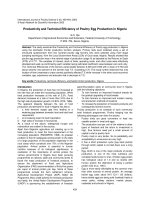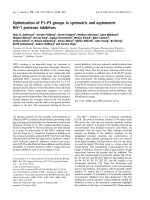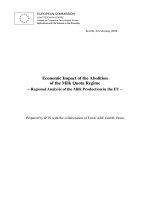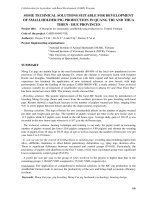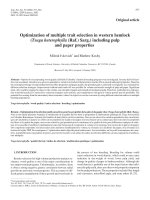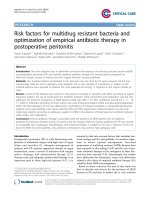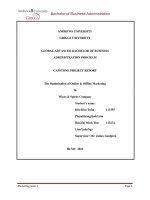optimization of nile tilapia production in ponds based on improved farm management practices in rwanda toi uu hoa san xuat ca ro phi trong ao nile dua tren thuc tien quan ly nong trai cai thien o rwanda
Bạn đang xem bản rút gọn của tài liệu. Xem và tải ngay bản đầy đủ của tài liệu tại đây (1.12 MB, 71 trang )
MINISTRY OF EDUCATION AND TRAINING
NHA TRANG UNIVERSITY
JEAN CLAUDE NDORIMANA
OPTIMIZATION OF NILE TILAPIA PRODUCTION IN
PONDS BASED ON IMPROVED FARM MANAGEMENT
PRACTICES IN RWANDA
MASTER’S THESIS
Nha Trang, July 2014
MINISTRY OF EDUCATION AND TRAINING
NHA TRANG UNIVERSITY
JEAN CLAUDE NDORIMANA
OPTIMIZATION OF NILE TILAPIA PRODUCTION IN
PONDS BASED ON IMPROVED FARM MANAGEMENT
PRACTICES IN RWANDA.
Master’s Thesis submitted in partial fulfilment of the requirements
for the award of a Master of Science in Aquaculture
FIELD’S CODE: 60620301
Supervisors:
Pham Quoc Hung, PhD
Nguyen Van Tien, PhD
Nha Trang, July 2014
i
DECLARATION
I hereby confirm that I am the sole author of this thesis and it has not been submitted in
part or in whole in regard to any other academic qualification.
Name: Jean Claude Ndorimana
Signature:
Date: July 2014
Matriculation Number: 54CH346
ii
DEDICATION
I dedicate this work to my late parents, brother and sisters. Your efforts and sacrifices are
behind everything achieved. You have been and will be in my heart;
To my beloved wife Triphine Niragire, your unfailing love and support are always a source
of my success;
To my lovely children Arnaud Shema Ruboneka and Armelle Ineza Sheja, your birth was
a source of strength and happiness for our family;
To my Uncle’s Family Fidèle Rwamuhizi, my Sisters Yvonne Mukandagano and
Jeannette Kagaga for their love and support a long my studies.
I also dedicate this work to all my friends and relatives.
iii
ACKNOWLEDGEMENT
To God be glory for His sustenance and strength throughout my studies. I am thankful to
my advisors Dr. Pham Quoc Hung and Dr. Nguyen Van Tien for their time,
encouragement and direction towards the success of this study.
A debt of gratitude is also owed to all my lecturers at the Institute of Aquaculture,
Foreign Affairs Department at Nha Trang University for providing a good atmosphere
and support throughout my studies.
I address special thanks to all colleagues of Aquaculture Master’s Programme students
for their friendship and company.
I am grateful to the Ministry of Agriculture and Animal Resources, Rwanda Agriculture
Board Authorities for the considerable support. I owe thanks to especially Dr Wilson
Rutaganira and Kigembe Fish Centre Technical and Management Team for their support,
collaboration and assistance.
I thank each and every one who helped me to accomplish this task.
iv
TABLE OF CONTENTS
DEDICATION ii
ACKNOWLEDGEMENT iii
TABLE OF CONTENTS iv
LIST OF TABLES viii
LIST OF FIGURES ix
LIST OF ACRONYMS x
ABSTRACT xi
INTRODUCTION 1
1. Back ground 1
2. Purpose 3
3. Objectives of the study: 4
3.1. Main objective 4
3.2. Specific objectives 4
4. Research questions 4
5. Significance of the study 4
6. Scope of the study 5
CHAPTER 1: LITERATURE REVIEW 5
1.1. The biology of Tilapia 6
1.1.1. Taxonomy of Tilapia 6
1.1.2. History and origin of Tilapia 8
1.1.3. General characteristics 8
1.1.3.1. Diagnostic Features 8
v
1.1.3.2. Habitat and Biology 9
1.1.4. Geographical distribution of Tilapia 10
1.1.4.1. World Tilapia production 10
1.1.4.2. Africa Tilapia production 12
1.1.4.3. Rwanda Tilapia production 13
1.2. Fish farming systems 16
1.2.1. Extensive fish farming systems 16
1.2.2. Semi-intensive fish farming systems 16
1.2.3. Intensive Fish farming systems 17
1.2.4. Integrated fish farming 17
1.3. Pond management systems 17
1.3.1. Pond management (preparation prior to stocking, routine management of
water quality after stocking) 17
1.3.2. Seed production (Breeding characteristics) 17
1.3.3. Feed and feeding 18
1.3.3.1. Feeds 18
1.3.3.1.1. Natural foods 18
1.3.3.1.2. Artificial feeds 18
1.3.3.2. Feeding 19
1.3.4. Fish diseases and their control 20
1.3.4.1. Types of fish diseases 20
1.3.4.2. Fish health management 21
CHAPTER 2. MATERIAL AND METHODS 24
2.1. Experimental design 24
vi
2.2. Methodology 25
2.2.1. Definition of key terms 27
2.2.1.1. Growth parameters 27
2.2.1.2. Feed Conversion Ratio (FCR) 28
2.3. Data collection 28
2.4. Data analysis 28
CHAPTER 3. RESULTS AND DISCUSSION 29
3.1. Brief geographical description of Rwanda 29
3.1.1. Climate 29
3.1.2. Demographics 30
3.2. Study area 30
3.2.1. Biophysical environment 30
3.2.1.1. Terrain and topography 30
3.2.1.2. Rainfall and sunstroke 31
3.3. RESULTS PRESENTATION 31
3.3.1. Monitoring of water quality parameters 31
3.3.2. Fish production parameters 32
3.3.2.1. Fish production parameters recorded 32
3.3.2.2. Fish survival, growth and feed utilization efficiency output 35
3.3.3. Economic analysis of Nile Tilapia fish pond production 37
3.4. DISCUSSION OF RESULTS 38
CHAPTER 4: CONCLUSION AND FUTURE PERSPECTIVES 45
4.1. Conclusion 45
vii
4.2. Recommendations for further research 45
REFERENCES 47
viii
LIST OF TABLES
Table 1.1. Distinguishing features of the three main farmed species 7
Table 3.1: Water quality parameters recorded during the experiment 32
Table 3.2: Production parameters recorded after 1 month (15
th
February 2014) 33
Table 3.3: Production parameters recorded after 2 months (15
th
March 2014) 33
Table 3.4: Production parameters recorded after 3 months (15
th
April 2014) 34
Table 3.5: Production parameters recorded after 4 months (15
th
May 2014) 34
Table 3.6: The mean value of SR, WG, SGR and FCR 35
Table 3.7: Comparison of economic analysis between improved farm management
and farmers’ management practices. 37
ix
LIST OF FIGURES
Figure 1.1. Global Capture production for Oreochromis niloticus (FAO 2013) 11
Figure 1.2. Global Aquaculture production for Oreochromis niloticus (FAO 2013) 11
Figure 3.1: Survival Rate trend recorded during the experiment 36
Figure 3.2: Mean Weight Gain trend recorded during the experiment 37
x
LIST OF ACRONYMS
AfDB: African Development Bank
BCEOM : Bureau Central d'Etudes et d'Equipements d'Outre-Mer
DO: Dissolved Oxygen
DRC: Democratic Republic of Congo
FAO: Food and Agriculture Organisation
FCR: Feed Conversion Ratio
GDP: Gross Domestic Products
MGR: Mean Growth Rate
MINAGRI: Ministry of Agriculture and Animal Resources
MT: Metric Tons
MWG: Mean Weight Gained
NACA: Network of Aquaculture Centres in Asia-Pacific
NEPAD: New Partnership for Africa's Development
NGO: Non Government Organization
NISR: National Institute o Statistics of Rwanda
NTU: Nha Trang University
NUR: National University of Rwanda
PAIGELAC: Projet d’Appui à l’Aménagement Intégré et à la Gestion des Lacs Intérieurs
PARN: Projet d’Aménagement des Ressources Naturelles
PPN: Projet Pisciculture Nationale
RAB: Rwanda Agriculture Board
SGR: Specific Growth Rate
SPN: Service Pisciculture Nationale
SR: Survival Rate
USAID: United States Agency for International Development
xi
ABSTRACT
The purpose of the study was to optimize the Nile Tilapia production in ponds based on
improved farm management practices in Rwanda. An experiment was carried out at
Kigembe National Fish Centre in Rwanda whereby six ponds of 53 m
2
each were
prepared and stocked with all males Nile Tilapia fingerlings of an average weight of 10g.
Three treatments (2 fingerlings/m
2
, 4 fingerlings/m
2
and 6 fingerlings/m
2
) with one
replicate each were set up. The key variables to gauge were, increasing the survival rate,
growth rate and reducing the FCR through an improved farm management practices
including good feeding, good fertilisation, control of predators and better control of water
quality parameters. The study was conducted for a period of 4 months (15
th
January-15
th
May 2014). The results were analysed using SPSS software and found that for the
Survival Rate (SR), there was no significant difference among treatments (P>0.05) and
the survival rate was above 80%. Regarding the SGR and FCR there was a significant
difference between the treatment 1 and the remaining treatment 2 and 3 which means that
fish have grown fast in the treatment 1 and used the supplied feeds effectively because
the FCR was lower compared to the other treatments. We compared the obtained
production results with the ones registered by farmers and realized that with the improved
farm management practices we can expect to attain 4,364 kg/ha/year for the first
treatment by which we applied the stocking density with that applied by farmers, while
the high production obtained by farmers was 3,500 Kg/ha/year. With the adoption of
improved farm management practices we managed to increase 864 kg of fish/ha/year.
Since the major production cost in fish farming is feeds, with this research, we have
found that with the improved farm management practice, we can reduce the production
cost while increasing the production and benefits.
1
INTRODUCTION
1. Back ground
Fish farming has been introduced in Rwanda by the Belgian colonial administration after
the Second World War by creating two large southern state stations Kigembe and
Rwasave (SARNISSA 2.013). As elsewhere, also, fish declined after the independence of
the country in 1962.
Since then several projects (EDF, CRSP, KUL, and University of Namur) attempted to
revive activity within MINAGRI, National University of Rwanda (NUR) and NGOs like
HELPAGE. It seems that these efforts are beginning to pay an integrated rural fish
farming, (whose poultry cum fish culture and rabbit cum fish) knows some development
(MICHA 2013).
Surveys conducted in Rwanda revealed that many small-scale fish farmers consider fish
to be a cash crop. Findings by Engle (Engle 1993.) indicated that fish farming provides
cash to the family and supplements the diet of the Rwandan farmer. Molnar et al. (Molnar
1991.) and Engle et al. (Engle 1993.) both found that fish production was the main cash
crop for over 50% of cooperative members and private pond-holders.
Small-scale fish farming in Rwanda may also be viewed as a means to improve food
security. Daily animal protein intake in Rwanda was estimated at 2.1 g per capita
(Wikock 1986); however, the Ministry of Agriculture (MINAGRI 1987) reported that an
adequate diet requires 5.9 g of animal protein daily.
With the projected 16 million people by 2020, the country will need 112,000 tons of fish
annually if the population is to catch up with the average fish consumption in Sub Sahara
Africa which is 6.7 kg (Rutaisire 2011).
2
Despite the enormous natural and socioeconomic potential, historical and current public
sector interventions coupled with current overwhelming national and individual farmer
interest for development of aquaculture, the sector remains extremely underdeveloped
with minimal contribution to the national fish harvest (Rutaisire 2011).
The current fish production was estimated at 17,158 MT, all these figures were from
capture fisheries because the aquaculture sector was not yet developed and yet its
statistics were not presented. The main species cultured in ponds and cages is Tilapia and
it is the same species which has a great market value and consumer’s preference (RAB
2011).
During 2010-2012, the Government invested a lot of money in order to boost aquaculture
through rehabilitating existing ponds, creating new ones and setting up demonstration
Tilapia production cages. The Government has constructed also a National Hatchery with
the capacity of providing 5 million quality Tilapia fingerlings per year and satisfy the
current need in seeds for the whole Country. At the same time, it interested and
sensitized the private sector to invest in aquaculture (intensive fish production, feeds and
seeds production) as well as Banks and Microfinance Institutions to provide loans to
aquaculture related activities and investments.
Considering the effort from the Government side, many investors could have got in and
contribute to the increase of fish production because the market is guaranteed as today the
country is importing more 10,000 MT which is nearly 1/2 of the current production (RAB
2013).
Investors are still reluctant to get involved in aquaculture activities as many trials of fish
production in ponds were conducted with the great sponsorship from the Government; the
present study intends to optimize Tilapia production in ponds based on improved farm
management practices in Rwanda.
3
The results from this study will help all actors in fish farming to know the effective fish
farming using improved farm management practices and this will allow the sector to be
profitable; this document will serve as a referential document to all actors in Tilapia pond
production in the Country.
Farmers will improve their daily management skills of fish farming activities and at the
same time the Financial Institutions will discover a new sector to invest their money
because they will understand clearly that the project is technically and economically
viable and start to provide loans to farmers and other willing investors.
The Government, after realizing that the sector is generating a lot of money, it will
continue to provide support to the investors in the sector in order to allow them to
contribute to the GDP because today it is contributing only 0,3% (Rutaisire 2011), also to
serve money that the Country is spending through imports of fishery products.
Again as there is a serious issue of pressure on land, this will be considered as a new
opportunity to invest money and power by Government and also to reduce the pressure
on natural stock which is declining due to overexploitation.
2. Purpose
Considering the environment for aquaculture development in Rwanda, the efforts that the
Government had invested in aquaculture development, considering also the market for
fisheries products available in the Country and even in the region, but people are still
relying on traditional subsistence farming characterized with low inputs and low output
as well as poor management.
The purpose of this research is to optimize the Nile Tilapia production in ponds based on
improved farm management practices in Rwanda.
4
3. Objectives of the study:
3.1. Main objective
To optimize the Nile Tilapia production in ponds based on improved farm management
practices in Rwanda.
3.2. Specific objectives
The specific objectives of this study will be to:
1. Optimize the Nile Tilapia yield through improved farm management practices;
2. To use effectively the farming inputs while increasing the production;
3. Demonstrate to farmers and other interested investors the importance of applying
improved farm management practices.
4. Research questions
1. Would the application of improved farm management practices contribute to the
optimization of Nile Tilapia production compared to the traditional farmers’ practices?
2. Is there any difference in the production cost if the improved farm management
practices are applied rather than the routine farmers’ practices?
5. Significance of the study
This study was aimed at optimizing the Nile Tilapia production in ponds based on
improved farm management practices in Rwanda. Understanding improved farm
management practices for the maximization of production will help all farmers and
investors in fish farming in Rwanda to change their farming techniques and adopt the
improved ones. The information generated will help extensionists in fish farming and
also provide basis for future research work.
5
6. Scope of the study
The study was carried out over a period of six months from January to June 2014 at
Kigembe National Fish Centre of Rwanda focusing on improving pond management
practices such as good feeding, good fertilisation, control of predators, control of water
parameter and regular control of fish diseases for the optimization of the Nile Tilapia
production in ponds.
6
CHAPTER 1: LITERATURE REVIEW
1.1. The biology of Tilapia
1.1.1. Taxonomy of Tilapia
Primarily all commercially important tilapias were grouped together under the genus
Tilapia, but in the mid 1970's the mouth brooding species were separated from the
species that incubated their eggs externally and were placed in the genus Sarotherodon.
Around 1983, from the maternal mouth brooder species of Sarotherodon, was separated
the genus Oreochromis. Consequently, an important aquacultural species such as Nile
tilapia was reported as Oreochromis niloticus.(Yadav 2006).
Commercially important tilapias are currently divided into three major taxonomic groups
based primarily on reproductive behavior (Popma 1995):
• Substrate incubators (Tilapia spp),
• Maternal mouth brooders (Oreochromis spp),
• Paternal and biparental mouth brooders (Sarotherodon spp).
Tilapias are endemic to Africa, Jordan, and Israel where more than 70 species have been
identified. However, few are commercially important and even fewer are of aquacultural
importance (Popma 1995). The common and scientific names of commercially important
species are:
Nile tilapia: Oreochromis niloticus
Silver perch (Jamaica) " : Oreochromis niloticus
Mojarra plateada (Colombia) “: Oreochromis niloticus
Blue tilapia: Oreochromis aureus
Java tilapia: Oreochromis mossambicus
Mossambique tilapia ":
Zanzibar tilapia: Oreochromis urolepis hornorum
7
"Red" tilapia: Oreochromis spp (1)
"White" or "pearl" tilapia: Oreochromis spp(2)
Galilee tilapia: Sarotherodon galilaeus
Black-chinned tilapia: Sarotherodon melanotheron
Congo tilapia: Tilapia rendalli
Oreochromis is the genus of greatest aquacultural importance. Twenty years ago all
commercially important tilapias were grouped under the genus Tilapia, but in the mid-
1970's the mouth brooding species were separated from the species that incubated their
eggs externally and were placed in the genus Sarotherodon. (Popma 1995)
Table 1.1. Distinguishing features of the three main farmed species
Species
Body
Fins
O. mossambicus
Dark colour
No bars on caudal fins
O. aureus
Bluish colour
Red margins on dorsal, caudal and anal fins
O. niloticus
Reddish to white
Prominent bars on caudal fins; white colour
strips on dorsal and anal fins
Source: (Nandlal 2004)
The Nile Tilapia is the most popular farmed species and its classification is given below:
“Family tree” of the Nile Tilapia according to (Nandlal 2004):
Phylum: Chordata - Notochord group of animals
Subphylum: Vertebrate - Animals with a backbone
Class: Osteichthyes - Bony fish
Order: Perciformes - Perch-like fishes
Family: Cichlidae - Cichlid fishes
Genus: Oreochromis - Mountain cichlid group
Species: Oreochromis niloticus - Nile tilapia
8
1.1.2. History and origin of Tilapia
Tilapia, that is native to Africa and Middle East, has emerged from mere obscurity to one
of the most productive and internationally traded food fish in the world.
The farming of tilapias in its crudest form is believed to have originated more than 4,000
years ago from Egypt (Modadugu 2004 ).
The first recorded scientifically oriented culture of tilapia was conducted in Kenya in
1924 and soon spread throughout Africa. Tilapia was later transplanted and became
established as a potential farmed species by the late 1940s in the Far East and a decade
later spread in the Americas (Modadugu 2004 ).
The majority of farmed tilapias are produced in countries with tropical or subtropical
climates. Tilapias are cultured in countries with temperate climates but must be held in
warm water to survive the cold winter months outdoors (Lovshin 1997).
1.1.3. General characteristics
1.1.3.1. Diagnostic Features
Body compressed; caudal peduncle depth equal to length. Scales cycloid. A knob-like
protuberance absent on dorsal surface of snout. Upper jaw length showing no sexual
dimorphism. First gill arch with 27 to 33 gillrakers.
Lateral line interrupted. Spinous and soft ray parts of dorsal fin continuous. Dorsal fin
with 16 – 17 spines and 11 to 15 soft rays. Anal fin with 3 spines and 10-11 rays. Caudal
fin truncated. Colour in spawning season, pectoral, dorsal and caudal fins becoming
reddish; caudal fin with numerous black bars (FAO 2013).
9
Coulour: changing with external conditions, light black; abdomen, white, with nine
longitudinal black stripes on body surface; nuptial Coulour can be found on male and
female tilapia during the reproduction period. External genital organs of the male and
female are different in appearance. The male has two pores: anus in front and
urinogenital pore in the rear. The female has three pores: anis in front, oviduct opening in
the middle, and urinary pore in the rear (NACA 1989).
1.1.3.2. Habitat and Biology
Occurs at a temperature range of 8 to 42
o
C, in a wide variety of freshwater habitats. Is
mainly diurnal. Feeds mainly on phytoplankton or benthic algae. Eggs and larvae nursed
in mouth of female. Omnivorous, but relying more heavily on plants (FAO 2013).
Nile tilapia males excavate nests communally and defend territory within a spawning
area; males have conspicuous breeding coulours and grow more rapidly after sexual
maturity. Egg care is primarily by the female, while the males guard the territory; after
hatching, Tilapia larvae are transferred to a pit, where secretions from their head glands
permit adherence to the substrate; During the post hatching period, once they are able to
swim effectively, juveniles of the mouthbrooding Oreochromis engage in forays of
increasing duration outside of the mouth, returning for refuge when necessary (William
2006).
Optimal spawning temperature is between 25
o
C and 30
o
C; reproductive cycles are 5 to 8
week intervals. The average duration of the incubation period and parental care is
approximately 20 days. Tilapia populations in larger lakes mature older and larger than
the same species growth in culture ponds. For example, O. niloticus usually matures at
approximately 10 to 12 months and 350 to 500 g in several East African Lakes, whereas
fish from the same population under conditions of near-maximum growth will reach
10
sexual maturity in farm ponds at an age of 5 to 6 months and size of 150 to 200 g
(William 2006).
1.1.4. Geographical distribution of Tilapia
Tilapia is now one of the main farmed aquatic species and a commodity with wider
distribution than Salmon in term of geographical regions where it can be farmed. Because
of its versatility as a fish product, the consumer acceptance for Tilapia is wider and
bigger than the acceptance for any other fish species and the market is increasing
(Suplicy 2013).
1.1.4.1. World Tilapia production
Total tilapia aquaculture increased to reach almost 1.5 million tons in 2002, which
compares to 500 000 tons in 1994. By far the main species cultured is Nile tilapia
(Oreochromis niloticus, about 80 percent of the total) and it is responsible for the
increase in production during recent years. Mozambique tilapia, the second major tilapia
species produced in fish farms, is stable at 45 000 tons (Josupeit 2005).
Nile tilapia is already the ninth (in terms of weight) single species in the world produced
in aquaculture (after three Molluscs: Pacific cupped oyster, Japanese carpet shell and
Yesso scallop, and five carp species: silver carp, grass carp, common carp,
bighead carp and Crucian carp). Nile tilapia production exceeds that of all salmon,
shrimp and mussel species (Josupeit 2005).
11
Figure 1.1. Global Capture production for
Oreochromis niloticus (FAO 2013)
Figure 1.2. Global Aquaculture production
for Oreochromis niloticus (FAO 2013)
The last three decades have seen significant developments in farming of tilapias
worldwide. In view of the increasing commercialization and continuing growth of tilapia
industry, the commodity is not only the second most important farmed fish globally, next
to carps but is also described as the most important aquaculture species of the 21st
century (Shelton 2002) cited by (Hussain M.G. 2007).
The fish is being farmed in about 85 countries worldwide (FAO 2002) and about 98% of
tilapia produced in these countries is grown outside their original habitats (Shelton 2002).
The main culture industries are in the Far East but they are increasingly being farmed in
Caribbean, Latin America and recently, in temperate countries where warm water
through artificial means (thermal effluents or geothermal springs) are also available
(FAO 2002).
According to (Fitzsimmons 2010), Tilapia is the most important aquaculture fish of the
21
st
Century:
Tilapias are second only to the carps as farmed food fish.
But Tilapias have unique characteristics that will facilitate its continued growth to
someday surpass carp production.
12
Tilapia is unique in its role as a live stock animal grown by subsistence farmers in
developing Countries around the World.
Tilapia is widely grown and exported to high value markets to be served in expensive
restaurants and grocery stores.
Community or specialty crop – both like chicken.
World Tilapia Production in 2010 was estimated at 3,200,000 MT and the top 10
producing Countries were: China, Egypt, Thailand, Indonesia, Philippines, Mexico,
Brazil, Taiwan, Vietnam, and Bangladesh (Fitzsimmons 2010).
1.1.4.2. Africa Tilapia production
Freshwater production dominates in Africa. One-third of total production is from tilapias,
especially Nile tilapia (Oreochromis niloticus). Almost half of the total reported
production from African aquaculture came from Egypt. However, between 1984 and
1997, the number of countries reporting production of over 500 tons per annum increased
from two (Egypt and Nigeria) to 11 (Democratic Republic of the Congo, Egypt,
Madagascar, Morocco, Nigeria, Seychelles, South Africa, Sudan, Tanzania, Tunisia, and
Zambia) (Randall 1999).
Africa potential producing Countries
Although tilapia originates in Africa, production in the region is very limited. In 2002,
total African aquaculture production was 193 000 tones (a marked increase on the 115
000 tones reported in 1999).
The bulk of this increase (and of production in general) is concentrated in Egypt (90
percent of total African cultured tilapia production), but production has reportedly
reached a plateau (Josupeit 2005).
